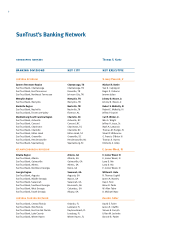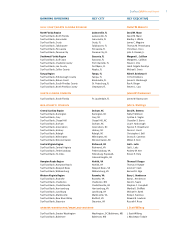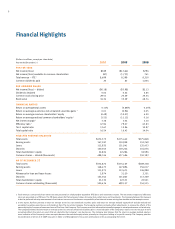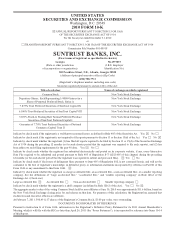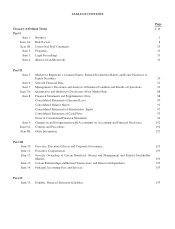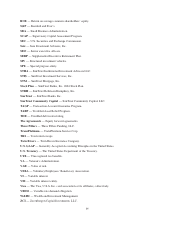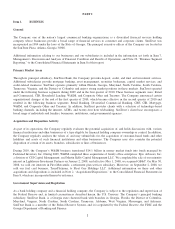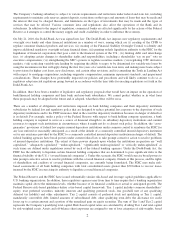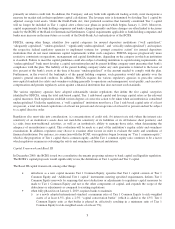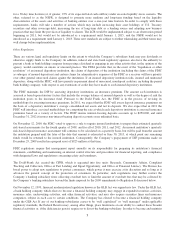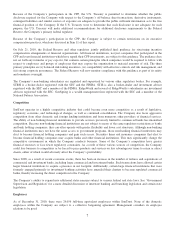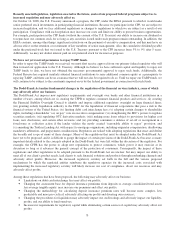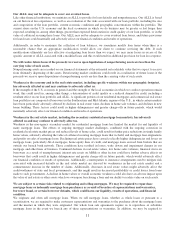SunTrust 2010 Annual Report Download - page 18
Download and view the complete annual report
Please find page 18 of the 2010 SunTrust annual report below. You can navigate through the pages in the report by either clicking on the pages listed below, or by using the keyword search tool below to find specific information within the annual report.The Company’s banking subsidiary is subject to various requirements and restrictions under federal and state law, including
requirements to maintain cash reserves against deposits, restrictions on the types and amounts of loans that may be made and
the interest that may be charged thereon, and limitations on the types of investments that may be made and the types of
services that may be offered. Various consumer laws and regulations also affect the operations of the Bank and its
subsidiaries. In addition to the impact of regulation, commercial banks are affected significantly by the actions of the Federal
Reserve as it attempts to control the money supply and credit availability in order to influence the economy.
On July 21, 2010, the Dodd-Frank Act was signed into law. The Dodd-Frank Act imposes new regulatory requirements and
oversight over banks and other financial institutions in a number of ways, among which are (i) creating of the CFPB to
regulate consumer financial products and services; (ii) creating of the Financial Stability Oversight Council to identify and
impose additional regulatory oversight on large financial firms; (iii) granting orderly liquidation authority to the FDIC for the
liquidation of financial corporations that pose a risk to the financial system of the U.S.; (iv) limiting debit card interchange
fees; (v) adopting certain changes to shareholder rights and responsibilities, including a shareholder “say on pay” vote on
executive compensation; (vi) strengthening the SEC’s powers to regulate securities markets; (vii) regulating OTC derivative
markets; (viii) restricting variable-rate lending by requiring the ability to repay to be determined for variable-rate loans by
using the maximum rate that will apply during the first five years of a variable-rate loan term, and making more loans subject
to provisions for higher cost loans, new disclosures, and certain other revisions; and (ix) amending the Truth in Lending Act
with respect to mortgage originations, including originator compensation, minimum repayment standards, and prepayment
considerations. These changes have profoundly impacted our policies and procedures and will likely continue to do so as
regulators adopt enacted regulations going forward in accordance with the time table for enacting regulations set forth in the
Dodd-Frank Act.
In addition, there have been a number of legislative and regulatory proposals that would have an impact on the operation of
bank/financial holding companies and their bank and non-bank subsidiaries. We cannot predict whether or in what form
these proposals may be adopted in the future and, if adopted, what their effect will be on us.
There are a number of obligations and restrictions imposed on bank holding companies and their depository institution
subsidiaries by federal law and regulatory policy that are designed to reduce potential loss exposure to the depositors of such
depository institutions and to the FDIC insurance fund in the event the depository institution becomes in danger of default or
is in default. For example, under a policy of the Federal Reserve with respect to bank holding company operations, a bank
holding company is required to serve as a source of financial strength to its subsidiary depository institutions and commit
resources to support such institutions in circumstances where it might not do so absent such policy. In addition, the “cross-
guarantee” provisions of federal law require insured depository institutions under common control to reimburse the FDIC for
any loss suffered or reasonably anticipated as a result of the default of a commonly controlled insured depository institution
or for any assistance provided by the FDIC to a commonly controlled insured depository institution in danger of default. The
federal banking agencies have broad powers under current federal law to take prompt corrective action to resolve problems
of insured depository institutions. The extent of these powers depends upon whether the institutions in question are “well
capitalized,” “adequately capitalized,” “undercapitalized,” “significantly undercapitalized” or “critically undercapitalized” as
such terms are defined under regulations issued by each of the federal banking agencies. Under the Dodd-Frank Act, the
FDIC has the authority to liquidate certain financial holding companies that are determined to pose significant risks to the
financial stability of the U.S. (“covered financial companies”). Under this scenario, the FDIC would exercise broad powers to
take prompt corrective action to resolve problems with the covered financial company. Details of this process, and the rights
of shareholders and creditors of covered financial companies, are currently being formulated. The FDIC may make risk-
based assessments of all bank holding companies with total consolidated assets greater than $50 billion to recover losses
incurred by the FDIC in exercising its authority to liquidate covered financial companies.
The Federal Reserve and the FDIC have issued substantially similar risk-based and leverage capital guidelines applicable to
U.S. banking organizations. In addition, these regulatory agencies may from time to time require that a banking organization
maintain capital above the minimum levels, whether because of its financial condition or actual or anticipated growth. The
Federal Reserve risk-based guidelines define a tier-based capital framework. Tier 1 capital includes common shareholders’
equity, trust preferred securities, minority interests and qualifying preferred stock, less goodwill (net of any qualifying
deferred tax liability) and other adjustments. Tier 2 capital consists of preferred stock not qualifying as Tier 1 capital,
mandatorily convertible debt, limited amounts of subordinated debt, other qualifying term debt, the allowance for credit
losses up to a certain amount and a portion of the unrealized gain on equity securities. The sum of Tier 1 and Tier 2 capital
represents the Company’s qualifying total capital. Risk-based capital ratios are calculated by dividing Tier 1 and total capital
by risk-weighted assets. Assets and off-balance sheet exposures are assigned to one of four categories of risk-weights, based
2


